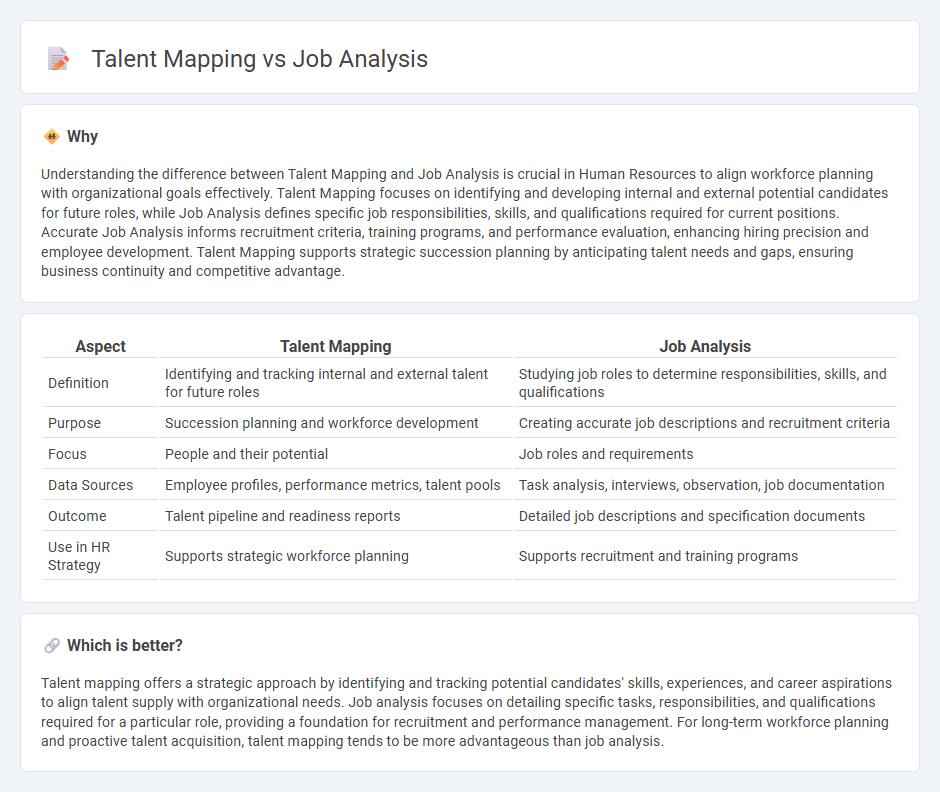
Talent mapping identifies and tracks high-potential candidates within and outside the organization to align workforce capabilities with future business needs. Job analysis systematically collects detailed information about job responsibilities, requirements, and work environments to create accurate job descriptions and improve recruitment processes. Explore further to understand how these strategies complement each other in effective human resource management.
Why it is important
Understanding the difference between Talent Mapping and Job Analysis is crucial in Human Resources to align workforce planning with organizational goals effectively. Talent Mapping focuses on identifying and developing internal and external potential candidates for future roles, while Job Analysis defines specific job responsibilities, skills, and qualifications required for current positions. Accurate Job Analysis informs recruitment criteria, training programs, and performance evaluation, enhancing hiring precision and employee development. Talent Mapping supports strategic succession planning by anticipating talent needs and gaps, ensuring business continuity and competitive advantage.
Comparison Table
| Aspect | Talent Mapping | Job Analysis |
|---|---|---|
| Definition | Identifying and tracking internal and external talent for future roles | Studying job roles to determine responsibilities, skills, and qualifications |
| Purpose | Succession planning and workforce development | Creating accurate job descriptions and recruitment criteria |
| Focus | People and their potential | Job roles and requirements |
| Data Sources | Employee profiles, performance metrics, talent pools | Task analysis, interviews, observation, job documentation |
| Outcome | Talent pipeline and readiness reports | Detailed job descriptions and specification documents |
| Use in HR Strategy | Supports strategic workforce planning | Supports recruitment and training programs |
Which is better?
Talent mapping offers a strategic approach by identifying and tracking potential candidates' skills, experiences, and career aspirations to align talent supply with organizational needs. Job analysis focuses on detailing specific tasks, responsibilities, and qualifications required for a particular role, providing a foundation for recruitment and performance management. For long-term workforce planning and proactive talent acquisition, talent mapping tends to be more advantageous than job analysis.
Connection
Talent mapping leverages job analysis to identify the specific skills, competencies, and experiences required for key roles within an organization, creating a strategic framework for talent acquisition and succession planning. Job analysis provides detailed insights into job responsibilities, performance criteria, and organizational needs, forming the foundation for effective talent mapping. This connection ensures that talent pipelines are aligned with organizational goals and future workforce demands.
Key Terms
Job Description
Job analysis systematically identifies the tasks, responsibilities, and skills required for a specific role, forming the foundation for an accurate job description. Talent mapping aligns organizational talent needs with these detailed job descriptions to strategically source and develop candidates who meet the role's criteria. Explore in-depth strategies to optimize job descriptions and enhance talent mapping effectiveness.
Competency Framework
Job analysis identifies role-specific skills and requirements by systematically studying tasks and responsibilities, forming the basis of a competency framework. Talent mapping assesses the current and potential skills of the workforce, aligning them with organizational goals to build a strategic competency framework for future talent needs. Explore how integrating job analysis and talent mapping enhances the design of effective competency frameworks for optimal workforce development.
Workforce Planning
Job analysis provides a detailed understanding of role requirements by identifying key skills, responsibilities, and qualifications necessary for effective workforce planning. Talent mapping strategically assesses current and future talent pools to align employee capabilities with organizational goals and anticipate skill gaps. Explore how integrating job analysis with talent mapping enhances workforce planning for optimal talent management.
Source and External Links
Job Analysis: Importance, Methods, and Implementation - This webpage provides an overview of job analysis, including its importance, methods, and implementation in human resource management.
Job Analysis: A Practical Guide - This guide offers a systematic approach to job analysis, detailing its role in recruitment, job design, and compensation decisions.
Complete Guide to Job Analysis for HR Professionals - This resource provides a structured process for conducting job analysis, focusing on identifying job responsibilities, skills, and tasks to enhance organizational effectiveness.
 dowidth.com
dowidth.com